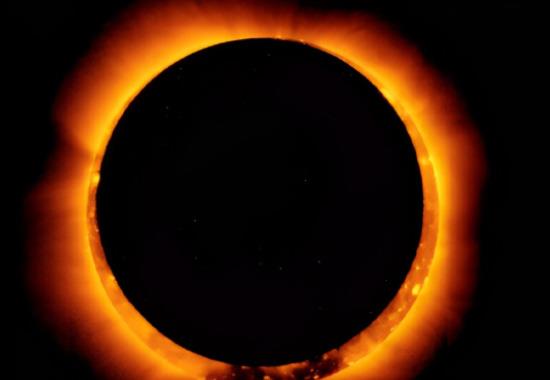The celestial stage is set for a breathtaking event as an annular solar eclipse is poised to grace the skies over North, Central, and South America on October 14, 2023.
This remarkable occurrence promises not only to captivate millions but also presents a unique opportunity for scientific exploration.
In this article, we provide you with essential details about the 2023 'Ring of Fire' eclipse, including when and where to witness this celestial spectacle.
Decoding the name 'Ring of Fire' eclipse:
The 'ring of fire' nickname is derived from the appearance of annular solar eclipses. These eclipses are akin to total solar eclipses, with one crucial distinction—the moon is at its farthest point from Earth in its orbit, preventing it from completely blocking the sun. Instead, viewers are treated to the stunning sight of the sun's fiery light surrounding the moon's shadow, forming the iconic 'ring of fire.'
Eclipse timing and path:
The annular solar eclipse will commence in the United States at 9:13 a.m. PT (12:13 p.m. ET), beginning its journey from the Oregon coast to Texas' Gulf Coast. Observers in Oregon, Nevada, Utah, New Mexico, and Texas will have the privilege of witnessing this celestial event. Additionally, parts of California, Idaho, Colorado, and Arizona will experience the lunar shadow. The eclipse will conclude in the U.S. at 12:03 p.m. CT (1:03 p.m. ET).
After crossing the U.S., the eclipse's path will extend across Mexico, Belize, Honduras, Panama, and Colombia, ultimately concluding off the Atlantic coast of Natal, Brazil.
Partial eclipse viewing:
Even if you're not in the direct path of the annular eclipse, you can still witness a crescent-shaped partial solar eclipse on October 14 in all 49 continental U.S. states, including Alaska. To find out when the eclipse will be visible in your area, consult NASA's interactive eclipse map.
Also Read: Who is Rebecca Loos? David Beckham's extramarital affair clarified in Netflix docuseries
Live stream option:
For those unable to witness the eclipse in person, NASA will provide a live stream starting at 11:30 a.m. ET on eclipse day. The stream will offer views from Albuquerque, New Mexico, Kirbyville, Texas, and White Sands, New Mexico, ensuring that you don't miss out on this celestial marvel.
Safety first:
Remember, it is never safe to look directly at the sun without appropriate protection. During an annular eclipse, there is no phase safe for naked-eye viewing, as the sun's light is never entirely blocked.
To safely observe the annular eclipse, use certified eclipse glasses or a handheld solar viewer. Specialized solar filters on telescopes, binoculars, or cameras are also safe alternatives.
The Next eclipse:
After this event, the next chance to witness a similar phenomenon in North America won't come until 2046. Given this long gap, it's crucial to seize the opportunity to witness the 2023 'Ring of Fire' eclipse safely.
Conclusion:
The 2023 'Ring of Fire' eclipse promises to be a visual extravaganza, offering a rare glimpse of celestial beauty. Whether you're in the path of the annular eclipse or observing the partial eclipse, remember to prioritize safety and use appropriate viewing tools. Don't let this unique event pass you by, as the next chance won't arrive for another 23 years.
So mark your calendars and prepare to be awed by the wonders of the cosmos on October 14, 2023!
